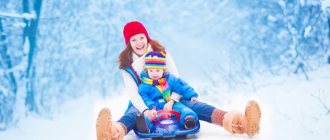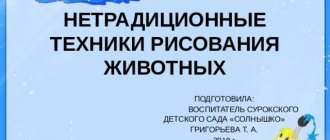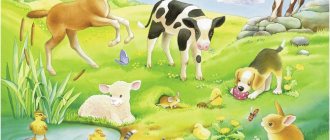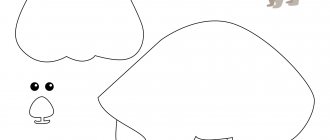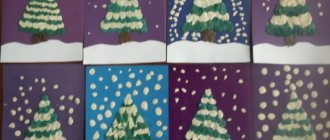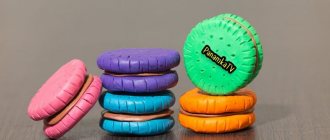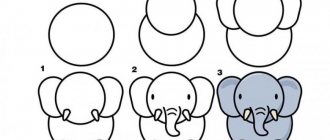The most complex form of speech activity is connected speech . In the process of speech development of a child, the leading role is played by the development of coherent speech. This contributes to the improvement of its other aspects.
Coherent speech in children without speech pathology occurs simultaneously with the development of activity, thinking and communication with people around them.
In children with general speech underdevelopment, the process of forming coherent speech is disrupted. This is due to the underdevelopment of the leading components of the language system: phonetic-phonemic and lexical-grammatical. Therefore, such children have significant difficulties in mastering coherent speech skills. For the second time, additional difficulties arise: deviations in the development of mental processes (memory, attention, perception). But thanks to the system of correctional classes, you can catch up.
“Compiling a story-description of wild animals according to a visual plan”
Lesson objectives:
Educational:
- improve the ability to write a descriptive story based on a visual plan;
- select attributes for words, coordinate adjectives with nouns in gender;
- activate vocabulary on the lexical topic “Wild Animals”;
Correctional and developmental:
- development of coherent speech;
- fine motor skills;
- visual attention and memory;
- logical thinking.
Educational:
- instilling discipline,
- ability to listen to others.
Equipment: plan diagram, ball, magic bag, pictures of wild animals; stars.
Supporting diagrams for the development of coherent speech in children
Supporting diagrams for the development of coherent speech in children
The study of the influence of training on the mental development of a child occupies an important place in child psychology and preschool pedagogy. The effect of training is directly dependent on its content and means. Numerous studies by domestic teachers and psychologists (, ) show that the use of modeling as a means of developing a variety of knowledge and skills has a positive impact on the intellectual development of children, that with the help of spatial and graphic models, orientation activities are relatively easily and quickly improved, and promising intellectual and practical actions are formed .
“MODELING” is the study of any phenomena or processes by constructing and studying models. Modeling has models as its object.
“MODEL” is any image (mental and conditional; images, descriptions, diagram, drawing, graph, plan) of any process or phenomenon (the original of this model), used as a substitute.
In preschool pedagogy, modeling is used to introduce children to nature, in the process of speech development, mastering elementary mathematical concepts, and developing children’s musicality. The peculiarity and significance of modeling lies in the fact that it makes visible the properties, connections, relationships of objects that are hidden from direct perception, which are essential for understanding facts and phenomena in the formation of knowledge that is associated in content with concepts.
The accessibility of the modeling method for preschoolers has been proven by psychologists (,). It is determined by the fact that the modeling is based on the principle of substitution. A real object can be replaced in children's activities by another object, image, sign.
In didactics, there are 3 types of models:
1. An object model in the form of a physical structure of an object or objects that are naturally connected (a planar model of a figure that reproduces its main parts, design features, proportions, relationships of parts in space).
2. Subject-schematic model. Here, the essential components identified in the object of cognition and the connections between them are indicated with the help of objects—substitutes and graphic signs.
3. Graphic models (graphs, formulas, diagrams).
In order for a model, as a visual and practical means of cognition, to fulfill its function, it must meet a number of requirements:
— Clearly display the basic properties and relationships that are the object of cognition;
— Be easy to understand and accessible to create actions with it;
— Vividly and clearly convey with its help those properties and relationships that must be mastered;
— Facilitate cognition (,).
In the psychological and pedagogical literature, a number of patterns in the formation of modeling in preschoolers have been identified:
— Modeling is performed on material familiar to children, based on knowledge acquired in the classroom or in everyday life;
— It is advisable to start with modeling individual specific situations, and later – with building models that have a generalized nature;
— You should start with iconic models, that is, those that retain a certain similarity with the modeled object, constantly moving to conditionally symbolic images of relationships;
— You should start with modeling spatial relationships, and then move on to modeling temporal, logical, etc.;
— Learning to model is easier if it begins with the use of ready-made models and then their construction;
— The process of learning to model ends with the internalization of actions, i.e., the transfer of planning into an internal plan.
The above facts direct attention to the development and application of subject models in teaching, which, of course, serves as a means of organizing and systematizing the child’s experience. Independent construction of models indicates the degree of formation of internal, ideal forms of modeling, which represent the core of mental abilities. Mastering logical forms of thinking is necessary in the future, during school education.
One of the main tasks of a preschool institution is to teach children coherent speech, that is, the ability to clearly and consistently express their thoughts. The main tasks of GCD for speech development are the following: expanding and clarifying the range of ideas about objects and phenomena of the surrounding reality; development of children's observation skills based on systematic exercises; mastering the language, its grammatical structure, and the communicative function of communication.
The main principles of organizing educational activities with preschool children, along with general didactic ones, are the subjectivity and clarity of teaching, which develops the focus of learning.
Subjectivity refers to the organization of learning in such a way that the subject being studied is, if possible, perceived by all senses: hearing, vision, touch, smell, tactile sensations. Subjectivity involves the consistent replacement of a living, natural object with a subject-schematic model
.
One of the factors that facilitate the process of developing coherent speech, according to , is visibility
. Visual learning involves the use, in addition to natural objects, of various types of visual aids: paintings, drawings, tables, diagrams, technical teaching aids.
The developmental orientation of education involves the use of methods and techniques that involve the development of the child’s higher mental functions: perception, memory, attention, thinking, etc. Examination of objects and pictures helps children name objects, their characteristic features, and actions performed with them.
The second auxiliary factor is the creation of an utterance plan
. The significance of this fact was pointed out by a famous psychologist. He noted the importance of sequential placement in the preliminary program, the scheme of all specific elements of the utterance, and also that each link of the utterance should be replaced in time by the next.
The teacher’s tasks include not only introducing the child to the world around him, but also teaching methods of examination, observation, the ability to highlight the essence, and establish relationships. Supporting diagrams, visual models, and symbols are very useful in this process.
Many practicing teachers have had to deal with a situation where, when asked to talk with older preschoolers on any topic (fruits, transport, professions, animals, school times, etc.), there is first a pause. Then the children talk about one or two characteristic features of the subject under discussion, and again there is a pause. Next, children often begin to repeat their friends’ answers, adding minor changes of their own. One gets the feeling that they didn’t remember anything from the topic covered, didn’t understand, and everything needs to be “pulled” out of them. But that's not true. They learned and remembered a lot, but they cannot express it correctly and according to plan.
The child comes across symbols, models, diagrams quite early: signs in a transport store, road signs, color schemes of services (ambulance, fire service, traffic signals), car icons, etc. All this attracts the child, he quickly and easily remembers these symbols, understands their meaning. Therefore, the use of supporting diagrams by the teacher in their work will help children highlight the main thing and find connections.
What are reference diagrams? Supporting schemes are the conclusions, the outcome, the essence of the material that the child must learn. Schemes, symbols, models should be “born” before the eyes of children at the moment the teacher explains new material in the form of drawings, schematic images, tables.
The purpose of supporting diagrams is “...to present the material being studied so that, based on the logical connections of the material (topic), it becomes accessible, imprinted in long-term memory” (), and facilitates memorization. Supporting patterns are like a rod on which the material is strung. Not a frozen model, but a system constantly supplemented with new material.
A preschooler is deprived of the opportunity to write down, make a table, or mark anything. In kindergarten classes, only one type of memory is mainly involved - verbal. Supporting schemes are an attempt to use visual and motor memory to solve cognitive problems, to include associative memory of jokes, joy, discoveries, gestures that accompanied the presentation of material.
Children often have difficulty with the following::
- independent determination of the main properties and characteristics of an object;
— establishing the sequence of presentation of the identified signs;
- retention in memory of this sequence, which is the plan of the story-description.
To avoid these difficulties, it is necessary to use model diagrams to compose descriptive stories about toys, vegetables, birds, animals, dishes, clothes, seasons, transport, etc.
Stages of working with reference diagrams
There are several stages in working with reference diagrams:
1. Introduction of elements, symbols.
For example, notations:
□ colors; □ forms;
□ size; □ actions.
2. The use of elements of supporting diagrams, symbols on all types of GCD, in various types of activities.
The child should not get used to the fact that this symbol is applicable only in one area. The symbol is universal.
3. Introduction of negatives.
For example, designations: □ not round; □ not edible.
4. Combination of symbols, “reading” in chains of symbols.
For example, in the upper left corner there is a large circle.
5. Children's independent search for images symbolizing some quality.
The task of this stage is to actively search for images and be able to justify your choice. For example, it was the children who suggested the image of two glasses: a full one and an empty one crossed out when drawing up a supporting diagram for the structure of an arithmetic problem (the answer must be complete).
6. Children’s creative creation of support patterns.
(According to the story of a teacher or friend, an individual sketch of plans, diagrams, riddles.)
Difficulties encountered when working with reference diagrams
When using supporting diagrams and symbols, children cannot always abstract from the symbol or conventional image; they begin to talk about the elements of the diagram, and not about the subject of knowledge or discussion.
This problem occurs in individual children at stages 1, 2, 3 and does not last long. Also, work can be difficult at stages 5-6 due to children’s limited visual experience, and at a younger age due to lack of knowledge of letters, numbers, and signs.
To overcome some timidity and uncertainty in the search for symbols by the children themselves, you can use “sketching” riddles. Such sketches cause noticeable revival and joy. For example:
No windows, no doors, no hands, no axe.
the room is full of people. (Cucumber) Hut built (Nest)
You can offer children a task for a collective search, discussion of images of joy, grief, wind, light, etc.
The use of support schemes in different types of activities.
Supporting diagrams and symbols have long been part of life and teaching in kindergarten (nature calendars, duty corners). The versatility of support diagrams and symbols allows them to be used very widely. For example, when familiarizing themselves with the surrounding world and nature, the teacher invites children to sketch symbols on separate small sheets of paper, which must then be laid out in order and stapled. You can use one marked and numbered sheet or a sheet in the form of an accordion book. The main thing is that the child does not have problems in the sequence of first depicting and then using the material. As a rule, children value their “author’s” books. You can set aside a place for them in a book corner or in the group’s children’s library. If you decide to design a child’s work as a book, do not forget about the cover, where the child can write its title, his name (the author), and if he cannot write, draw what it is about (animal, transport, fruit, etc. ). Here is an example of a “record” on the topic “Vegetables”:
A person plants seeds in the ground, takes care of them, and then harvests vegetables.”
When reading fiction, sketching the sequence of events, characters, characteristics of heroes, etc. can be used.
Using supporting diagrams, students can be trained to compose creative, descriptive stories, and stories based on a plot picture. For example: “Write a story. You see the middle of it in the picture, but you don’t see what happened before and how the story ended. These parts of the story need to be invented.”
Let us dwell in more detail on the principles of drawing up and using model diagrams
.
A sheet of cardboard 45x30 cm is divided into 6 squares (according to the number of characteristic features of objects, objects or seasons that need to be described).
Description of toys
1. Color
. The first square contains red, yellow, blue and green color spots. It is important that they do not have a clear, recognizable shape for children, then attention is better concentrated on color and there is no shift in the concepts of color and shape.
2. Form
. The second square depicts geometric shapes. They are not painted so that children's attention is concentrated on their shape. If the shape of the toy being described is complex (doll, lunar rover), this point is omitted, and the corresponding part of the diagram is covered with a sheet of white paper.
3. Magnitude
. There are 2 toys of contrasting sizes drawn in a square. Children are reminded that, in addition to the concept of “big-small”, they must use the concepts of “tall-short”, “long-short”, “wide-narrow”, “thick-thin”.
4. Material.
3 rectangles of the same size made of metal foil, plastic, are glued to this part of the sheet. They depict the material accordingly.
5. Toy parts.
Several rings of the pyramid are drawn separately. If the toy is whole and cannot be divided into parts, then this item is omitted.
6. Actions with a toy.
A hand is depicted with fingers spread apart. Since manipulations with toys can be very diverse, it is important when explaining this point to children to use antonyms and other techniques for expanding children’s verbal vocabulary.
It will not be difficult for a teacher to select toys that will use all the points in the diagram when describing them. This is a pyramid, a nesting doll, a box with a mosaic, a stroller for dolls, etc. Later, when the children have mastered the scheme well, you can give toys in the description of which not all points are used, for example: a ball, a jump rope, a cube, a bear, a doll, etc. . P.
An example of a story according to a diagram, compiled by a 5-year-old child.
This ball is multi-colored, it is round, big, you can’t even wrap your hands around it. It is made of plastic, and it is not like rubber, rubber is softer. You can throw the ball up and play football, and you can also roll it on the ground, but in a group you can’t play with the ball - you can break the glass.
Description of clothing items
1. Color.
There are 3-4 color spots in a square: red, yellow, blue and green.
2. Material.
3 pieces of fabric (wool, chintz, silk or nylon) of the same shape and size are glued onto the cardboard. Naturally, before compiling descriptive stories about clothing, it is necessary to conduct classes with children to familiarize themselves with the named and other materials, so that the children examine them, touch them and remember the names of the fabrics.
3. Parts of clothing.
A sundress or suit is depicted, all parts of which (collar, cuffs, sleeves, frill, belt, etc.) are located at a short distance from each other. Children are introduced in advance to the names of all parts of the costume.
4. Seasonality of clothing.
The square contains a sun, a snowdrop, a yellow maple leaf and several snowflakes, which symbolize summer, spring, autumn and winter, respectively.
5. Who is the clothing intended for?
Symbolic images of a man, woman, boy and girl.
6. Actions with clothes.
A hand is depicted with fingers spread apart.
Here is an example of a dress description according to this pattern.
This dress is red with white polka dots. It's very beautiful. I think it's wool.
has
long sleeves, a beautiful lace collar, beautiful red ties... and lace on the cuffs, and pockets with lace.
Leather belt with a plastic buckle... You can wear this dress in
winter, spring, and autumn... Well, you can wear it in summer, when it’s not hot.
It's best to wear it when visiting... This dress is for a girl. What can you do with it? Hang it on a hanger, iron it if it gets wrinkled, and if it gets dirty, wash it. It should be noted that even at the highest level of speech development, without diagrams, children are not able to compose such detailed narrative stories.
Description of utensils
1. Color.
There are 3 - 4 color spots in a square.
2. Form.
A square, a circle and a rectangle are drawn. If children are already familiar with three-dimensional forms - on a sheet of paper there is an image of a cylinder, a ball, etc., preschoolers can use these terms when describing objects.
3. Magnitude.
Large and small bowls are drawn.
4. Material.
Rectangular pieces of the same size made of foil, plas, are glued onto the cardboard. They depict the various materials from which the dishes are made. In addition, with children it is clarified that the bulk of the dishes are made from clay and porcelain - materials that are difficult to display on the diagram. Wooden, metal, glass, and plastic utensils are also examined and compared by touch, weight, sound produced, etc.
5. Parts of dishes.
A teapot is depicted, the parts of which are located at a short distance from each other. Children are reminded of the names of the parts of the dishes: bottom, walls, handle, lid, spout, etc.
6. Actions with dishes.
A hand is depicted.
Let's give an example of a child describing a large teapot according to this diagram.
This is a teapot. It is large, all white, and there are red rowan branches painted on the walls and on the lid... and also a gold stripe on the lid and on the spout. The teapot is round and pot-bellied. It's big, you could probably pour a lot of water into it.
10
people is enough.
This teapot is made of clay and then painted. The
teapot has a bottom, a spout, walls, a lid, a handle on the side and a handle on the lid.
Tea is poured into a kettle, then boiling water is poured, and then poured into cups for guests. You have to be careful...well...carrying this kettle, otherwise you'll break it and burn
your feet.
Description of the seasons
Compiling a story according to this scheme is preceded by preparatory work, which is carried out by teachers on walks and in their free time. These are systematic observations of the state of nature and weather, their changes. As experience shows, words denoting abstract concepts associated with natural phenomena, for example, cloudy sky, drizzling rain, withered grass, etc., must be repeated many times so that they enter the child’s vocabulary.
1. Sun.
In the first square of the diagram, a solar disk with rays is drawn.
Children talk about the sun at certain times of the year: it shines but does not warm, it is often behind the clouds, it is hot
, etc.
2. Sky.
This part of the sheet shows a blue sky with clouds. Children should tell what kind of sky they most often see at one time or another of the year: clear, cloudless or gray, cloudy, covered with clouds, etc.
3. Earth.
A piece of land with grass on it is drawn. Children talk about what the ground looks like at different times of the year: covered with snow or damp from rain, the grass on it is dry and yellow or the first grass appears on it, etc.
4. Trees.
2 trees are depicted (possibly without leaves).
It is better not to draw coniferous trees, because their appearance is the same in all seasons. Children talk about deciduous trees at different times of the year: the leaves on the trees turn yellow and fall off;
buds appear; covered with bright green foliage
5. People.
(seasonal clothing)
are
symbolically depicted.
A hanger is drawn at the top of the square. This means talking about changes in people's clothing and the reasons for this phenomenon. For example: in winter it is cold and people wear winter coats and fur coats, warm hats and boots, mittens and scarves
, etc.
6. Animals.
(seasonal changes in the life of wild animals) 2 animals familiar to children are drawn in outline, for example a hare and a squirrel.
The child talks about changes in the lives of animals depending on the time of year. For example: animals in the forest do not have enough food, they hibernate;
animals store food for the winter, change their “fur coats” , etc.
7. Birds.
(seasonal changes in the life of birds, classification) Two birds familiar to children are depicted in outline, for example a crow and a swallow.
Children reflect in the story seasonal changes in the life of birds. For example: preparing to fly away or making nests, hatching chicks
, etc.
8. Children's activities.
(games, work) There is a snowman, a net and a boat in the square.
Children tell what they do outside at one time or another of the year: collecting dry leaves, skiing, making a snow woman, swimming in the river
, etc.
Description of vegetables and fruits
1. Color.
Color spots are drawn in the square.
2. Form.
Geometric shapes: circle, triangle and oval.
3. Magnitude.
Two fruits of contrasting size are depicted, for example a large and a small apple.
4. Taste.
Candy and lemon are drawn, products that contrast in taste.
5. Place of growth.
A tree and a garden bed are depicted.
6. How to use
for
food.
Plates, forks, spoons and knives are depicted. In preliminary work with children, it is clarified which vegetables and fruits are eaten raw, which are boiled, fried, canned, fermented, pickled, etc.
Let us give an example of a story compiled by a child according to a diagram.
Green cabbage, round. It can be very large and heavy, and sometimes smaller. It tastes a little bitter. Cabbage grows in the garden, right on the ground.
has
a lot of clothes and all without fastenings.
And
they eat raw cabbage, I always eat it when my mother cooks soup, that is, cabbage soup.
They also make borscht from cabbage and salt it... and they also make solyanka from cabbage. The use of diagrams when composing descriptive stories significantly facilitates the mastery of this type of coherent speech. In addition, the presence of a visual plan makes such stories clear, coherent, complete, and consistent. Model diagrams can be used not only for composing descriptive stories, but also for comparative stories, coming up with riddles about objects and puzzles, as well as in such an important and complex section of work as teaching children to independently pose questions.
Get text
Using mnemonic tables when compiling descriptive stories about animals and birds.
Using mnemonic tables when compiling descriptive stories about animals and birds.
Mnemonics – translated from Greek – “the art of memorization.” This is a system of methods and techniques that ensure successful memorization, preservation and reproduction of information, knowledge about the characteristics of natural objects, the world around us, effective memorization of the structure of a story, and, of course, the development of speech. Using mnemonics you can solve the following problems:
– development of coherent and dialogic speech in children;
– developing in children the ability, with the help of graphic analogy, as well as with the help of substitutes, to understand and tell familiar fairy tales and poems using a mnemonic table;
– teaching children correct sound pronunciation;
– development in children of mental activity, intelligence, observation, the ability to compare, and identify significant features;
– development of mental processes in children: thinking, attention, imagination, memory.
I want to share with you mnemonic tables for writing descriptive stories about wild and domestic animals, forest and domestic birds.
A sample of writing descriptive stories using an outline.
Scheme 1 Writing stories about pets
A cow is a domestic animal. She has a light brown skin, a large body, a round head and a tail with a panicle at the tip. The cow has hooves on its feet. She has horns on her head. The cow moos: "Moo-Moo." In summer she eats lush grass, and in autumn hay. A cow lives in a barn. A baby cow is called a calf. The cow gives man milk and meat.
Scheme 2 Writing stories about wild animals
A squirrel is a wild animal. She has a red coat, a small body and a bushy tail. The squirrel has tufted ears and claws on its paws. The squirrel eats nuts and collects supplies in a hollow for the winter. In winter, the squirrel feeds on tree bark and jumps from branch to branch. Baby squirrels are called squirrels. The squirrel is a pleasure to watch.
Scheme 3 Writing stories about poultry
A rooster is a domestic bird. It is big and colorful. It has two large wings, two paws, claws and spurs on its paws. The head has a crest, beak and eyes. The body is covered with feathers. He crows and loves to peck grain. He doesn't know how to fly, he can only fly up to something high. The rooster lives in the chicken coop with the chickens. Its chicks are called chicks. It gives feathers, down and meat to a person.
Scheme 4 Compiling stories about birds
This is a starling. Small bird. Its body is covered with black feathers and its head has a bright orange beak. The starling can sing beautifully and eats grains and insects. He lives close to people in the forest or park. The starling makes its nests from twigs, and people build birdhouses for starlings, which they hang on trees. In the spring, this bird gives birth to nestling chicks. This is a migratory bird. People believe that spring begins with the arrival of the starling.
LiveInternetLiveInternet
Quote from Tatyana57
Read in full In your quotation book or community!
SPEECH DEVELOPMENT. LEXICAL TOPIC “POWERIES”.
CHILDREN SHOULD KNOW THE NOUNS: hen, rooster, chickens, duck, drake, ducklings, goose, goose, goslings, turkey, turkey poults, birds, poultry house, poultry house, chicken coop, egg, shell, feather, beak, legs, paws, membranes , wings, tail, head, body, nest, perch, laying hen, hen. ADJECTIVES: small, big, large, yellow, colorful, motley, beautiful, fat, clumsy, loud, caring, shy, waterfowl. VERBS: walk, fly, swim, cluck, cackle, crow, cackle, quack, squeak, chatter, search, peck, pinch, run, play, carry, sit, hatch, breed, care. CHILDREN SHOULD BE ABLE TO ANSWER THE QUESTIONS: 1. WHO SPEAKS HOW? Chicken - cackling, clucking Rooster - crowing Geese - cackling Ducks - quack... 2. Gather a family. Rooster - hen - chickens. Duck – drake – ducklings. Goose - goose - goslings. Turkey - turkey - turkey poults. 3. WHOSE? WHOSE? WHOSE? WHOSE? Feather (whose?) - chicken, goose, duck, rooster... Tail (whose?) - chicken, goose... Eyes (whose?) - duck, turkey... 4. COMPLETE A DESCRIPTIVE STORY ACCORDING TO PLAN. Who is this? What is the appearance like? What habits? Who are the cubs? What does it eat? What benefits does it bring? 5. COMPARE TWO BIRDS. What are the similarities and differences (according to the description plan).
Dear parents! With your children, look at pictures of poultry: rooster, chicken, duck, goose, turkey. Children should be able to show and name them. Explain: a person keeps these birds near his house in special houses; they are called poultry; poultry brings benefits to humans: they provide meat, eggs, feathers; a person takes care of them: feeds them grain, gives them water. Learn: - what parts of the body do birds have: head, beak, neck, torso, wings, tail, legs; comb, beard, spurs (on a rooster); - who gives what voice: the rooster crows (“cuckoo-re-coo”); chicken - cackling (“cluck-clack”); duck - quacks (“quack-quack”); goose - cackling (“ha-ha-ga”); turkey - chattering (“bl-bl-bl”); - names of young poultry: for a hen - chick, chicks; a duck has a duckling, ducklings; a goose has a gosling, goslings; for a turkey - turkey hen, turkey poults. Invite your child to play the game “Name it kindly” with the words: rooster, hen, chick, duck, duckling, beak, wing, comb, tail. Learn a riddle about any poultry: It wanders importantly through the meadow, comes out of the water dry, wears red shoes, gives soft featherbeds. (Goose.) I am all golden, soft and fluffy. I am the chicken’s child, and my name is... (chicken). A scarlet comb, a pockmarked caftan, a double beard, an important gait, gets up before everyone else, sings vociferously. (Rooster.)
He clucks, fusses, calls the children, gathers everyone under his wings. (Chicken) White feathers, Red comb. Who's that on the peg? (Peter the Cockerel) He wanders importantly through the meadow, comes out of the water dry, wears red shoes, gives soft featherbeds. (Goose) Along the river, along the water, a string of boats floats, A ship goes ahead, Leads them behind it. (Duck with ducklings) He walks importantly around the yard, swells up like a balloon. And he’s not too lazy to shout ball-bal-ball all day long. (Turkey) The birds flew in and sat down near the river. They cooed: “Gul-gul.” The river sang: “Bul-gul.” (Pigeons)
Series of messages “Speech Development”:
Part 1 - POSTER. BERRIES. Part 2 - SPEECH DEVELOPMENT. LEXICAL TOPIC “POWERIES”. Part 3 - DEVELOPMENT OF CONNECTED SPEECH IN CHILDREN THROUGH DIDACTIC GAMES. Part 4 - DEVELOPING THE CONNECTED SPEECH OF CHILDREN 3-4 YEARS OLD. MAKING A SENTENCE FROM THE PICTURE. ... Part 19 - GYMNASTICS FOR FINGERS. Part 20 - ARTICULATIVE GYMNASTICS. Part 21 - TIPS OF A Speech Therapist.
Summary of the lesson on speech development "Wintering birds"
author: Turshatova Olga Nikolaevna in
feeder MBDOU No. 2 of compensating type
Summary of the lesson on speech development "Wintering birds"
Lesson notes on
speech development in the middle group
"Wintering Birds"
Target:
Clarify and expand ideas about wintering birds. To consolidate knowledge about the structure of birds. Form the concept of “wintering birds”. Learn to answer questions in complete sentences. Make sentences correctly.
Tasks:
— Educational:
clarify and expand children’s ideas about wintering birds and their appearance; activate vocabulary on the topic (wintering birds, bullfinch, tit, feeder, bird food, takes care of birds); learn to answer questions in complete sentences.
— Developmental: develop children’s cognitive interest in the life of wintering birds, observation, cognitive abilities - speech, memory, attention, logical thinking.
— Educational:
develop the ability to listen to the stories of other children; cultivate a caring attitude towards wintering birds.
Demo material:
riddles about wintering birds, a letter, a feeder, food, cut out birds
(
wintering and migrating, a diagram for a story about a bird, pictures of birds cut into pieces
.
Lesson progress
Educator:
Guys, I’m going to kindergarten today, and a bullfinch is flying towards me. I look, and there is an envelope in his beak. He threw it to me from above and flew away. I wonder what is written in the letter, let's read it?
Children:
Let's
I, the Bullfinch, live in the forest. Today there is a commotion : some birds have flown away, others remain.
I do not get it. And signature: snow
Educator:
Let us get up, go into the forest and figure out which birds should fly away and which ones should stay with us and send a letter to the bullfinch.
Children:
Let's.
Educator:
One, two, three, turn around and find yourself at the edge of the forest! The children turn around and find themselves at the edge of the forest. Bird trills sound.
Educator
: Look, guys, how beautiful it is around. Do you hear the birds singing? The bullfinch's friends are meeting us.
Educator:
Guys, look how many birds there are on the Christmas tree. And here is the bullfinch himself, let’s ask him to tell him what happened.
Educator:
Bullfinch, bullfinch, what happened, what’s all this commotion?
Guys, he says that he won’t understand which birds should stay and which ones should fly away. Let's take a look and figure out whether all the birds have flown away or not.
Children come up to the Christmas tree, look and name the birds: swallow, starling, cuckoo.
Educator:
What kind of birds are these?
Children:
Migratory.
Educator:
Why are they called that?
Children:
Because they fly to warmer climes.
Educator:
Why are they flying away? Why can't they stay here with us?
Children:
They will freeze from the cold and die of hunger, because these birds are insectivores, they feed on insects, and in winter all insects sleep and hide in the ground. Let's send these birds to the south, where they can feed themselves.
Educator:
Guys, what birds are left? Let's name them.
Children call
birds: tit, pigeon, bullfinch, sparrow, woodpecker, crow, magpie.
Educator:
What kind of birds are these?
Children:
Wintering.
Educator:
Why are they called that?
Children:
Because they spend the winter with us, flying from the forests closer to humans.
Educator:
Bullfinch, you understand which birds should stay with us and which ones should fly away.
Children sit on chairs
Guessing riddles.
Educator:
Guys, do you like to solve riddles?
Children:
Yes
Educator:
- A mischievous boy in a gray army jacket
Snoops around the yard, collecting crumbs. (sparrow)
- Red-breasted, black-winged, loves to peck grains,
With the first snow on the mountain ash he will appear again. (bullfinch)
- Fidgety, small, all yellow bird,
Loves lard and wheat. (titmouse)
- I'm knocking on wood, I want to get a worm,
Even though he hid under the bark,
It will still be mine. (Woodpecker.)
- He flies all night, catching mice.
And it will become light,
Sleep flies into the hollow. (Owl.)
(Children attach pictures of birds to the board)
Didactic game for attention “Which bird is missing?”
Educator:
Guys, the bullfinch asks, do you know what parts birds are made of?
Educator:
Children, let's look at the bird and tell the bullfinch about birds.
Educator:
Well done. Guys, the bullfinch asks, do you know what birds eat?
Children:
Grains, bread crumbs, cereals, berries, lard.
Game "Collect the picture"
Children are given envelopes with cut-out pictures depicting wintering birds.
- Take out the pictures cut into pieces and try to assemble them. (For children who find it difficult to complete the task, the teacher gives visual support in the form of a complete picture.)
The teacher asks the children.
- Tell me what kind of birds did you make? And you?
- Now guys, let's play
Physical education minute.
Birds raise their beak (raise and lower their head)
.
The birds spread their wings (raise and lower straight arms)
.
Birds peck grains (squat and tap their index fingers on their knees)
.
The birds sing songs (turn right and left, waving their arms and saying “Shadow - shadow”
).
Birds stretch their legs (alternately raise their legs, bending their knees)
.
Birds jump and fly (jumping on two legs)
We inhale air through our nose (slowly raise our hands - inhale, release - exhale)
.
The children flew and sat on the chairs.
Educator: A
Now guys, listen, I’ll tell you about the sparrow, and you listen carefully. (teacher's story)
Educator:
And now, whoever of you wants to talk about the sparrow, you can look at the diagram when telling it. (children's stories
Educator:
and you would like to help the birds so that they do not die of hunger.
Children:
Yes
Educator:
Here we have a feeder, we will hang it on our site today, and every day we will put food for the birds in the feeder.
Result:
Our walk through the forest has come to an end.
What did you enjoy doing most today? What wintering birds do you remember? Can you name them? What new and interesting things did you learn today? How can we take care of birds. Summary of the lesson on speech development "Wintering birds"

